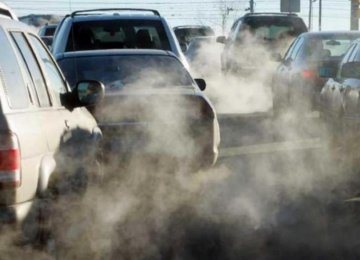Proper maintenance of cars through regular technical inspections will not only reduce harmful emissions, but can also improve vehicle performance, extending the life of the vehicle and safeguarding the environment.
"Proper technical inspections of vehicles can bring about a 25% decline in air pollution," said Reza Shayesteh, supervisor of Baharestan's Department of Environment, during a visit to three technical inspection centers for heavy and light vehicles, Mehr News Agency reported.
"The extension of inspections from two to five years ratified by the Majlis in 2010 saw a 40% drop in the visits to inspection centers," he said.
In developed countries where high-quality and low-emission vehicles roam the streets, cars depreciate in value and are phased out after completing their service life of five years.
Shayesteh also lamented the designated centers' failure to install catalytic converters and carbon canisters on vehicles to reduce emission of harmful gases.
The catalytic converter is placed in the exhaust pipe to convert hydrocarbons, carbon monoxide and NOx into less harmful gases by using a combination of platinum, palladium and rhodium as catalysts.
Carbon canisters are designed to decrease the amount of vehicle air pollution while increasing its fuel efficiency by trapping vapor rather than allowing it to escape the fuel tank, and feeding it back into the engine.
The official stressed that the issue is high on the respective workgroup's agenda and all technical inspection centers across the county must take measures to ensure every car is equipped with these devices.
Other Problems
Part of the problem for the car industry in Iran is the lax enforcement of automotive regulations. The country's traffic police are overwhelmed in large cities by the sheer number of vehicles and only have limited manpower to catch violators.
The issue of annual motor service checks is also cause for concern. Unlike western nations, many drivers see the vehicle testing scheme as a nuisance rather than a legal requirement.
One driver said, "Even when you take your car to get checked at the official service centers, the people are so overwhelmed by the number of people going to get their cars checked that they don't inspect major issues and simply issue a vehicle check certificate."
Another respondent remarked, "The vehicle inspection centers did actually catch my faulty Peugeot 405 engine last year and made me pay for the repairs there and then."
The testing centers are usually overcrowded on working hours with people having to get there at dawn to beat the crowds.
Overworked inspectors along with clapped out vehicles and a population lacking in funds to undertake fundamental repair are the main issues causing pollution to increase in recent years.
Another failure of the system is that a particular region is responsible for checking vehicles, with small towns and villages not being held up to the same scrutiny as city drivers. One can often drive to villages and see un-roadworthy vehicles moving around.
How Europe Checks
European countries like the United Kingdom and Ireland have privatized the process of checking vehicles. Britain's Motor Ordinance Test or simply MOT has been in place since the 1960s. Its key difference with the Iranian system is the use of private garages to test vehicles.
This allows private garages, who possess the needed testing equipment, to issue vehicle test certificates, outsourcing the issue from the central government. The vehicle testing certificates are provided by the Driving and Vehicle Standards Agency, which is the national organization that runs through one database to reduce fraudulent certificates.
The private garages are also checked regularly with "secret shoppers" to check if they are acting fraudulently by passing vehicles through.
Although the British government does offer government ordained centers to test public and private vehicles, they are not well known and generally used by taxis and buses.





